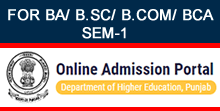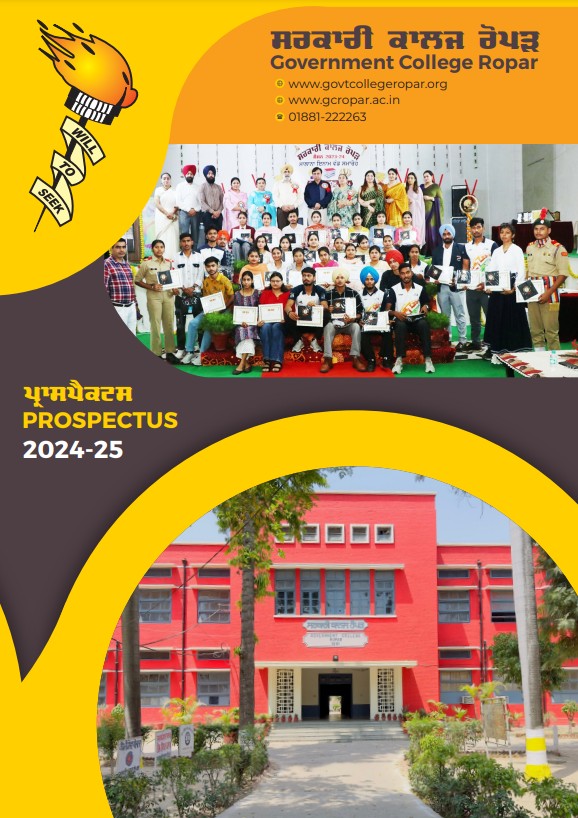CERTIFICATE COURSE IN COMPUTER AIDED ACCOUNTING
Objective of the Course:
To provide practical training of computerized Accounting and its package Tally.
Learning outcomes:
After completion of this course, the students would be able to handle accounts of an organization. This course seeks to enhance the skills needed for computerized accounting system and to enable the students to develop simple accounting applications
Duration of the course:
-
Certificate course: 6 months
Eligibility: Any student enrolled in degree program . INSTRUCTIONAL DESIGN PROGRAMME STRUCTURE
GC-CAA1 BASICS OF COMPUTERIZED ACCOUNTINGSR. NO.
COURSE TITLE
CREDIT
GC-CAA1
BASICS OF COMPUTERIZED ACCOUNTING
6
GC-CAA2
APPLICATIONS OF TALLY IN ACCOUNTING
6
GC-CAA3
DIGITALIZED FINAL ACCOUNTS
6
TOTAL
18
Max. Marks: 100
External: 70
Internal: 30
Pass: 35%
Credits: 6
INSTRUCTIONS FOR THE PAPER SETTER/EXAMINER:-
The syllabus prescribed should be strictly adhered to.
-
The question paper will consist of three sections: A, B, and C. Sections A and B will have four questions from the respective sections of the syllabus and will carry 10 marks each. The candidates will attempt two questions from each section.
-
Section C will have fifteen short answer questions covering the entire syllabus. Each question will carry 3 marks. Candidates will attempt any ten questions from this section.
-
The examiner shall give a clear instruction to the candidates to attempt questions only at one place and only once. Second or subsequent attempts, unless the earlier ones have been crossed out, shall not be evaluated.
-
The duration of each paper will be three hours.
-
INSTRUCTIONS FOR THE CANDIDATES:
Candidates are required to attempt any two questions each from the sections A and B of the question paper and any ten short questions from Section C. They have to attempt questions only at one place and only once. Second or subsequent attempts, unless the earlier ones have been crossed out, shall not be evaluated.
SECTION A
Computerized Accounting : Accounting process, Accounting principles and concepts, Computerised Accounting Systems: Basics of Computerised accounting systems - Meaning, Importance; Difference between computerized, accounting and manual accounting; Software programs for computerized accounting.
SECTION B
Factors, affecting selection of suitable Computerised accounting software; Procurement and installation of Computerised accounting software.
Accounting Database Management: Use of MS Excel and other software packages such as QuickBooks India, Zoho Books, MargERP 9+, Vyapar, myBooks.
GC-CAA2 APPLICATIONS OF TALLY IN ACCOUNTING
Max. Marks: 100
External: 70
Internal: 30
Pass: 35%
Credits: 6
INSTRUCTIONS FOR THE PAPER SETTER/EXAMINER:
-
The syllabus prescribed should be strictly adhered to.
-
The question paper will consist of three sections: A, B, and C. Sections A and B will have four questions from the respective sections of the syllabus and will carry 10 marks each. The candidates will attempt two questions from each section.
-
Section C will have fifteen short answer questions covering the entire syllabus. Each question will carry 3 marks. Candidates will attempt any ten questions from this section.
-
The examiner shall give a clear instruction to the candidates to attempt questions only at one place and only once. Second or subsequent attempts, unless the earlier ones have been crossed out, shall not be evaluated.
-
The duration of each paper will be three hours.
INSTRUCTIONS FOR THE CANDIDATES:
Candidates are required to attempt any two questions each from the sections A and B of the question paper and any ten short questions from Section C. They have to attempt questions only at one place and only once. Second or subsequent attempts, unless the earlier ones have been crossed out, shall not be evaluated.
SECTION A
Accounting using Tally: Creation of Company Gateway of Tally Menu Buttons, Features and Continuation; Accounting Group Ledger, Cost Category, Currency; Voucher Types and Classes; Accounts Vouchers; Reversing Journal; Memorandum Voucher, Optional Voucher, Post-dated Voucher, Bill wise details, Interest; Money Receipt and Cheques, Debit and Credit Notes Creating and Configuring New Company Accounts: Account masters’ maintenance, Account vouchers maintenance, inventory master’s maintenance.
SECTION B
Voucher and Entry in Books of Accounts: Types of vouchers; Selection of voucher type for transactions; Vouchers for income and Expenditure; Vouchers Entry: Voucher Number and date settings, Voucher entry with more than one debit or credit accounts, Editing and deleting a voucher, Printing of Voucher and Cheque. Multiple Price list Quotation Purchase Enquiry; Order Performa Invoice, Sales Purchase & Rejection Voucher; Additional Purchase; Effective Rates Invoice.
Generation of Reports: Cash Book, Ledger Accounts.
Suggested Readings:
-
Agarwal, Garima. Computerised Accounting: Himalaya Publishing House.
-
Chheda, Rajesh. Learn Tally. ERP 9 with GST and E-way Bill: Ane’s Student Education.
-
Grewal, T.S. Introduction to Accountancy. S. Chand and Co.
-
Gupta, R.L and Gupta, V.K. Principles and Practice of Accounting. Sultan Chand & Sons.
-
Haneef and Mukerjee. Accountancy I. Tata McGraw Hill Company.
-
Jain, S.P. and Narang, K.L. Accountancy I, Kalyani Publishers.
-
Jawahar Lal. Financial Accounting. Himalaya Publishing House.
-
Maidasani, Dinesh. Mastering Tally: Firewall Media
-
Nathani, Asok K. Tally ERP 9 Training Guide. BPB Publications
-
Sahgal, Deepak. Fundamentals of Financial Accounting. Tax Man Publication.
-
Tally Education Pvt Ltd. Official Guide to Financial Accounting using Tally ERP 9 with GST
-
Tally ERP 9 book advanced user, Swayam Publication (www.tallyerp9book.com)
-
Tarang, Tally ERP 9. Computer World Publications.
-
Tulsiani, Accountancy I: Tata McGraw Hill Company
-
Yogeshwran, G. Computerised Accounting. PBP Publications.
Note: Latest edition of text books may be used GC-CAA3 DIGITALIZED FINAL ACCOUNTS.
Max. Marks: 100
External: 70
Internal: 30
Pass: 35%
Credits: 6
INSTRUCTIONS FOR THE PAPER SETTER/EXAMINER:-
The syllabus prescribed should be strictly adhered to.
-
The question paper will consist of three sections: A, B, and C. Sections A and B will have four questions from the respective sections of the syllabus and will carry 10 marks each. The candidates will attempt two questions from each section.
-
Section C will have fifteen short answer questions covering the entire syllabus. Each question will carry 3 marks. Candidates will attempt any ten questions from this section.
-
The examiner shall give a clear instruction to the candidates to attempt questions only at one place and only once. Second or subsequent attempts, unless the earlier ones have been crossed out, shall not be evaluated.
-
The duration of each paper will be three hours.
-
INSTRUCTIONS FOR THE CANDIDATES:
Candidates are required to attempt any two questions each from the sections A and B of the question paper and any ten short questions from Section C. They have to attempt questions only at one place and only once. Second or subsequent attempts, unless the earlier ones have been crossed out, shall not be evaluated.
SECTION A
Need, significance and applications of digitalized final accounts. Digitalized Trial Balance and Final Accounts : Introduction, Definitions of trial balance, Features of trial balance, Objectives of preparing trial balance, Method for preparation of trial balance, various errors encountered while preparing the trial balance.
SECTION B
Preparation of final Accounts, Similarities and Difference between Balance Sheet and Trial Balance, Difference between Balance Sheet and Profit and Loss A/C, Reports Displaying, Accessing Reports, Modifying Reports, Financial Statements, Display of Balance Sheet, Display Profit and Loss Account.
Suggested Readings:
-
Agarwal, Garima. Computerised Accounting: Himalaya Publishing House.
-
Chheda, Rajesh. Learn Tally. ERP 9 with GST and E-way Bill: Ane’s Student Education.
-
Grewal, T.S. Introduction to Accountancy. S. Chand and Co.
-
Gupta, R.L and Gupta, V.K. Principles and Practice of Accounting. Sultan Chand & Sons.
-
Haneef and Mukerjee. Accountancy I. Tata McGraw Hill Company.
-
Jain, S.P. and Narang, K.L. Accountancy I, Kalyani Publishers.
-
Jawahar Lal. Financial Accounting. Himalaya Publishing House.



.gif)
